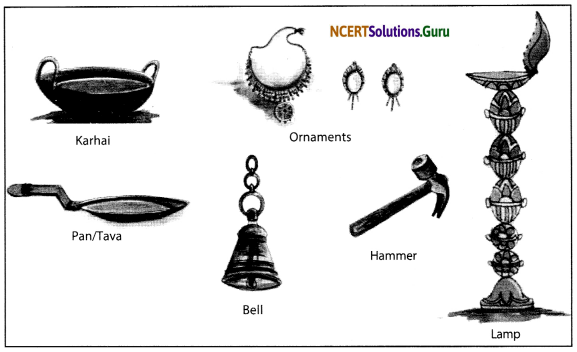Inside our Earth Class 7 Questions and Answers Provided helps you to answer complex Questions too easily. You can use them while preparing for board exams and all of them are given by subject experts. Reading NCERT Solutions for Class 7 Social Science Geography Chapter 2 Inside our Earth familiarizes you with the kind of questions appearing in the board exams. Students are advised to read these solutions on a regular basis to score well.
Inside our Earth Class 7 Questions and Answers Geography Chapter 2
Make your learning experience enjoyable by preparing from the quick links available on this page. Use the Class 7 SST Geography Chapter 2 NCERT Solutions and get to know different concepts involved. All the Solutions are covered as per the latest syllabus guidelines. Knowing the NCERT Class 7 Geography Chapter 2 Questions and Answers helps students to attempt the exam with confidence.
Class 7 Geography Chapter 2 NCERT Textbook Questions and Answers
Question 1.
Answer the following questions.
- What are the three layers of the earth?
- What is a rock?
- Name three types of rocks.
- How are extrusive and intrusive rocks formed?
- What do you mean by a rock cycle?
- What are the uses of rocks?
- What are metamorphic rocks?
Answer:
(i) Three layers of the earth are:
(a) Crust
(b) Mantle
(c) Core
(ii) Any natural mass of mineral matter that makes up the earth’s crust is called a rock.
(iii) Three types of rocks are:
- Sedimentary rocks
- Metamorphic rocks
- Igneous rocks which are also known as primary rocks
(iv) When the molten lava comes on the earth’s surface, it rapidly cools down and becomes solid. Extrusive igneous rocks are formed in such a way on the crust. Sometimes the molten magma cools down deep inside the earth’s crust. Solid rocks so formed are called extrusive igneous rocks.
(v) The process of transformation of the rock from one to another is known as the rock cycle. When the molten magma cools it solidifies to become igneous rock. These igneous rocks are broken down into small particles that are transported and deposited to form sedimentary rocks.
When the igneous and sedimentary rocks are subjected to heat and pressure they change into metamorphic rocks. The metamorphic rocks which are still under great heat and pressure melt down to form molten magma. This molten magma again can cool down and solidify into igneous rocks.
(vi) The hard rocks are used for making roads, houses and buildings. Stones are used in many games, e.g. seven stones (pitthoo), hop-scotch (stapu/ kit kit), and five stones (gitti).
(vii) Igneous and sedimentary rocks can change into metamorphic rocks under great heat and pressure. For example, clay changes into slate and limestone into marble.
![]()
Question 2.
Tick the correct answer.
(i) The rock which is made up of molten magma is:
(a) Igneous
(b) Sedimentary
(c) Metamorphic
Answer:
(a) Igneous
(ii) The innermost layer of the earth is:
(a) Crust
(b) Core
(c) Mantle
Answer:
(b) Core
(iii) Gold, petroleum and coal are examples of:
(a) Rocks
(b) Minerals
(c) Fossils
Answer:
(b) Minerals
(iv) Rocks which contain fossils are:
(a) Sedimentary rocks
(b) Metamorphic rocks
(c) Igneous rocks
Answer:
(a) Sedimentary rocks
(iv) The thinnest layer of the earth is:
(a) Crust
(b) Mantle
(c) Core
Answer:
(a) Crust
Question 3.
Match the following:
| Column I | Column II |
| 1. Core | (a) Earth’s surface |
| 2. Minerals | (b) Used for roads and buildings |
| 3. Rock | (c) Made of silicon and alumina |
| 4. Clay | (d) Has definite chemical composition |
| 5. Sial | (e) Innermost layer |
| (f) Changes into state | |
| (g) Process of transformation of the rock |
Answer:
1. (e)
3. (b)
4. (f)
5. (c)
Question 4.
Give reasons.
(i) We cannot go to the centre of the earth.
(ii) Sedimentary rocks are formed from sediments.
(iii) Limestone is changed into marble.
Answer:
(i) It is not possible to reach to the centre of the earth because for that we have to dig a hole of 6000 km deep on the ocean floor.
(ii) The smaller rock particles (sediments) are compressed and hardened to form layers of rocks. These types of rocks are called sedimentary rocks.
(iii) Igneous and sedimentary rocks can change into metamorphic rocks under great heat and pressure. For example, limestone changes into marble.
![]()
Question 5.
For fun.
(i) What are the minerals most commonly used in the following objects?
(ii) Identify some more objects made up of different minerals.

Answer:

(ii) Students discuss with teacher and can make a list of such items.
Hope the data shared above regarding the NCERT Class 7 Social Science Geography Chapter 2 Inside our Earth PDF has aided in your exam preparation. If you ever need any assistance you can always reach us and our team will guide you at the soonest possibility.